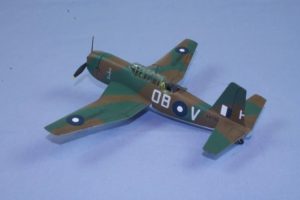Vultee Vengeance II, AN709/DB*V, RAF, Khumbirgram, India, 1942
This is from my shelf of doom. I started this at least 20 years ago, if not longer, when I was able to find the kit for a small sum…somewhere. As part of a “junkyard dogs” group build I finally finished it.
The Subject
The Vengeance was produced as a response to the success of the Stuka, but by the time it was ready for service the dive bomber was no longer in vogue given most fighters could carry the same bomb load, more accurately, with less crew at risk, do additional missions, and in a smaller package. Given the war situation Vultee was contracted to produce the Vengeance I and II by the MAP and most were delivered to either India or the RAAF.
The key difference between the Mk I and II were the wing incidence. The Mk I had a near zero incidence whilst useful in the vertical dive for stability meant that in cruise flight it was nose high and the pilot had difficulty seeing ahead. The Mk II fixed the incidence but the loss of accuracy and inability to make the dive vertically meant the aircraft was less suited for its intended role. Many were used as target towing tugs.
AN709 represents a Mk II used in India. However some online references indicate it may have operated out of Australia or New Guinea.
The Model
This is an old Frog-spawn kit released by Smer in the 90’s. The decals were actually quite good so I was able to use them. When I first started the kit I used a dark green that was more olive drab and a brown that was more light earth. The actual colors should have been a Dark Earth and Dark Green uppersurface to MAP specifications (meaning a quite close match) and a lower surface that was close to Sky. After arrival it would have received a repaint in local colors as required.
I’m a bit all over the place with the references for this aircraft so I decided to use a Foliage Green and Earth Brown (very close to Dark Earth) over an RAAF Sky Blue (darker than RAF Sky Blue, but not by much). I did this because the national markings are the RAAF colors, not the FEAF colors used in India.
The canopy is overly thick, and needs a vacform replacement. I may replace it soon as I acquired a nice vacform machine earlier this year and need to practice. I instead decided to focus on figuring out how to create a split radio aerial that is 3 lines from wingtip to tail to wingtip with a center wire to the post. Then a fourth wire runs from the center wire to the starboard side of the fuselage where a junction is located. My solution was to use Uschi 0.001 thread, three lengths joined at the one end with acrylic glue. Once cured it was a bit stiff, so I drilled a small hole in the vertical tail, applied CA and dipped the Uschi end in accelerator, then touched it to the hole. That set the one end. Next was the center to the post, then I took each of the two wingtip lines and cut them slightly shorter and glued them. The last bit was applying some glue to the central wire and fuselage attachment point, then running a bit of Uschi between them. Frankly it was much easier than I thought and I like the appearance.
Summary
This is one of those odd aircraft I wanted on my shelf decades ago, but just never got around to finishing. If I ever do another it will be a modern kit to replace this one.
Thanks for looking…




